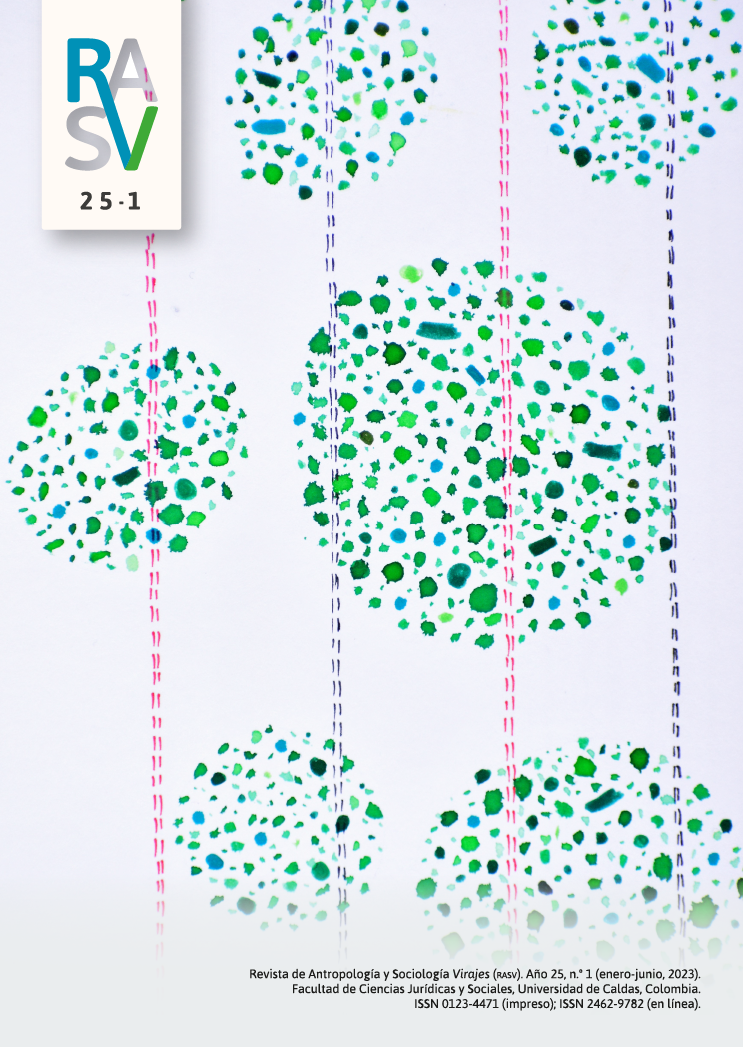Authors
Abstract
The endorsement of the Peace Agreement between the government and the FARC-EP led many sectors of Colombian society —including indigenous organizations— to share their conceptions of peace in different spheres, among which digital social networks played a predominant role. This article seeks to describe the transitional narratives and meanings of peace mobilized by indigenous organizations in these networks during this period. Methodologically, virtual ethnography is used. It shows how indigenous organizations resize the limits of the transition while problematizing that its beginning and its end are reduced to the end of the armed conflict, the strengthening of liberal democracy and the expansion of the neoliberal model of development based on extractivism. In this way, they affirm the importance of taking the good life and the liberation of Mother Earth as horizons of peace.
References
Arjona, A. (2021). War-to-peace transitions and the behavioural legacies of civil war: A plea for looking beyond violence. International Journal of Drug Policy, 89, 103154. https://doi.org/10.1016/j.drugpo.2021.103154
Basset, Y. (2018). Claves del rechazo del plebiscito para la paz en Colombia. Estudios Políticos, 52, 241-265.
Calderón, C. y Galeano, M. (2018). Infraestructuras para la paz en los territorios, una mirada desde la Institucionalidad Local: Caso El Carmen de Bolívar (tesis de maestría). Universidad de Cartagena, Colombia.
Cardozo, Ó. (2022). Una mirada etnográfica a la vida de excombatientes asentados en el espacio territorial de capacitación y reincorporación de Monterredondo, norte del Cauca. Maguaré, 36(2), 21-50.
Castillejo, A. (2015). La imaginación social del porvenir: reflexiones sobre Colombia y el prospecto de una Comisión de la Verdad. Documento de Trabajo Clacso.
Castillejo, A. (2017). Introducción. En A. Castillejo (ed.), La ilusión de la justicia transicional: perspectivas críticas desde el Sur global. Uniandes.
Centro de Investigación y Educación Popular (Cinep). (2016). Movilización por la Paz en Colombia: una infraestructura social clave para el posacuerdo. Informe Especial. CINEP.
De Sousa Santos, B. (2010). Refundación del Estado en América Latina: Perspectivas desde una epistemología del Sur. Instituto Internacional de Derecho y Sociedad.
El Colombiano. (6 de octubre de 2016). “Estábamos buscando que la gente saliera a votar verraca”: Juan C. Vélez. El Colombiano. https://bit.ly/2VlhAQ9
Escobar, A., Álvarez, S. y Dagnino, E. (2001). Política cultural y cultura política. Una nueva mirada sobre los movimientos sociales latinoamericanos. ICANH, Taurus.
Fabian, J. (2014). Time and the Other. How anthropology makes its object. Columbia University Press.
Galaviz, T. (2018). La Infraestructuras para la paz y justicia transicional en Colombia. Revista Reflexiones, 97(2), 123-135.
Gómez-Suárez, A. (2016). El triunfo del No. Icono.
González, M. F. (2017). La “posverdad” en el plebiscito por la paz en Colombia”. Nueva Sociedad, 269, 114-126.
Jaramillo, I. C. (2019). Finding and Losing Feminism in Transition: The Costs of the Continuum Hypothesis for Women in Colombia. En Governance Feminism: Notes from the Field (pp. 434-478). University of Minnesota Press.
Knight, M. y Özerdem, A. (2004). Guns, Camps and Cash: Disarmament, Demobilization and Reinsertion of Former Combatants in Transitions from War to Peace. Journal of Peace Research, 41(4), 499-516. https://doi.org/10.1177/0022343304044479
Koselleck, R. (1993). Futuro Pasado: para una semántica de los tiempos históricos. Paidós.
Krampe, F., Hegazi, F. y Vandeveer, S. (2021). Sustaining peace through better resource governance: Three potential mechanisms for environmental peacebuilding. World
Development, 144, 105508. https://doi.org/10.1016/j.worlddev.2021.105508
Leal-Martínez, A. (2022). El campamento Libertad Simón Trinidad, un espacio transcarcelario del posconflicto. Maguaré, 36(2), 89-126. https://doi.org/10.15446/mag.v36n2.102862
McEvoy, K., Shirlow, P. y McElrath, K. (2004). Resistance, transition and exclusion: Politically motivated ex-prisoners and conflict transformation in Northern Ireland. Terrorism and Political Violence, 16(3), 646-670. https://doi.org/10.1080/09546550490509991
Organización Nacional Indígena de Colombia (ONIC). (2022). Nuestra historia. https://www.onic.org.co/onic/nuestra-historia
Oviedo, J. (2011). El uso de las redes sociales en las campañas electorales (tesis de maestría). Instituto Tecnológico y de Estudios Superiores de Monterrey, México.
Pfeiffer, S. (2014). Infraestructura de paz en Colombia. Berghof Foundation.
Prado, P. (2010). Participación política en Internet y redes sociales en la campaña presidencial de Colombia 2010 (tesis de maestría). Universidad Pontificia Javeriana, Colombia.
Sádaba, I. (2012). Acción colectiva y movimientos sociales en las redes digitales. Aspectos históricos y metodológicos. Arbor, 188, 781-794.
Sinisterra-Ossa, L. y Valencia, I. H. (2020). Orden social y violencia en Buenaventura: Entre el outsourcing criminal y la construcción de paz desde abajo. Revista CS, 32, 103-129. https://doi.org/10.18046/recs.i32.3650
Smith, P. (2005). Why war? The University of Chicago Press.
Theidon, K. (2014). Pasts Imperfect: Talking about Justice with Former Combatants in Colombia. En A. L. Hinton y D. E. Hinton (eds.), Genocide and Mass Violence. Memory, Symptom, and Recovery (pp. 321-341). Cambridge University Press. https://doi.org/10.1017/CBO9781107706859.019
Uribe, M. (2018). Infraestructuras de paz y estatalidad en Colombia. Perfiles latinoamericanos, 26(51), 167-189.
Zúñiga-Upegui, P., Arnaiz-Schmitz, C., Herrero-Jáuregui, C., Smart, S. M., López-Santiago, C. A. y Schmitz, M. F. (2019). Exploring social-ecological systems in the transition from war to peace: A scenario-based approach to forecasting the post-conflict landscape in a Colombian region. Science of The Total Environment, 695, 133874. https://doi.org/10.1016/j.scitotenv.2019.133874

 PDF (Español)
PDF (Español)
 FLIP
FLIP



















